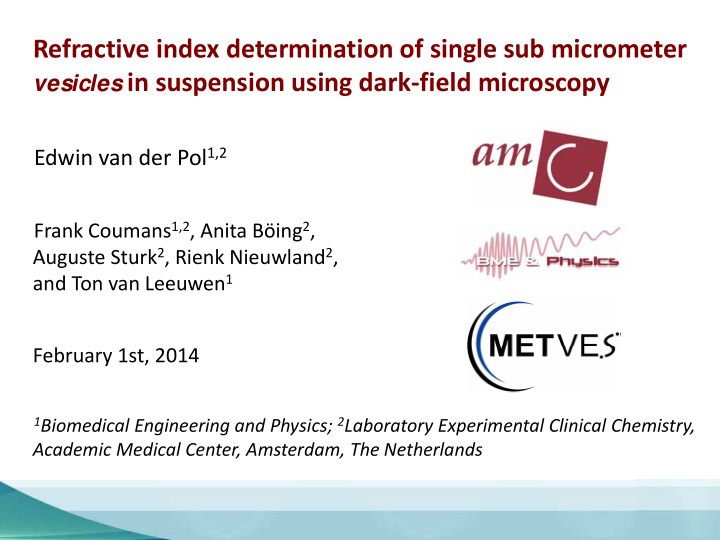



Refractive index determination of single sub micrometer vesicles in suspension using dark ‐ field microscopy Edwin van der Pol 1,2 Frank Coumans 1,2 , Anita Böing 2 , Auguste Sturk 2 , Rienk Nieuwland 2 , and Ton van Leeuwen 1 February 1st, 2014 1 Biomedical Engineering and Physics; 2 Laboratory Experimental Clinical Chemistry, Academic Medical Center, Amsterdam, The Netherlands 1
Acknowledgements Academic Medical Center University of Oxford Biomedical Engineering and Physics Chris Gardiner Laboratory Experimental Clinical University of Birmingham Chemistry Paul Harrison NanoSight Ltd. European Association of National Patrick Hole Andrew Malloy Metrology Institutes (EURAMET) Jonathan Smith The European Metrology Research Programme (EMRP) is jointly funded by the EMRP participating countries within EURAMET and the European Union 2
Introduction to extracellular vesicles cells release vesicles: spherical particles with phospholipid bilayer specialized functions clinically relevant van der Pol et al., Pharmacol Rev (2012) 3
Determine refractive index to identify vesicles vesicles (1.36 ≤ n ≤ 1.45 for d > 500 nm)* lipoproteins (n = 1.45 ‐ 1.60) protein aggregates (n = 1.53 ‐ 1.60) measure the refractive index to distinguish vesicles from lipoproteins and protein aggregates * Konokhova et al., J. Biomed. Opt. (2012) 4
Refractive index to relate scatter to diameter 3 flow cytometry is widely used to detect vesicles refractive index provides scatter to diameter relation 5
Refractive index of vesicles is unknown ? refractive index of vesicles is unknown detection range is unknown 6
Goal determine the refractive index of sub micrometer vesicles in suspension distinguish vesicles from lipoproteins and protein aggregates provide insight in the vesicle detection range of flow cytometry 7
Methods ‐ single particle tracking obtain particle diameter d by tracking the Brownian motion of single particles (Stokes ‐ Einstein equation) measure scattering power P derive particle refractive index n(P,d) from Mie theory 8
Methods ‐ setup EMCCD Commercial instrument + Nanosight NS ‐ 500 microscope objective NA = 0.4 particles in solution laser beam power = 45 mW glass wavelength = 405 nm figure adapted from Nanosight Ltd, UK 9
Methods ‐ data acquisition and processing intensity corrected for camera shutter time and gain minimum tracklength 30 frames discard scatterers that saturate the camera 10
Methods ‐ samples Polystyrene beads ( n =1.63) Thermo Fisher Scientific, USA Silica beads ( n =1.45) Kisker Biotech, Germany vesicles Human urinary vesicles differential centrifugation protocol from metves.eu cells 11
Methods ‐ approach measure light scattering of beads describe measurements by Mie theory derive particle diameter from Brownian motion validate technique with a beads mixture determine the refractive index of vesicles 12
Results ‐ scattering power versus diameter of polystyrene beads 13
Results ‐ scattering power versus diameter of polystyrene beads described by Mie theory 14
Results ‐ scattering power versus diameter of polystyrene and silica beads 15
Results ‐ scattering power versus diameter of a mixture of polystyrene and silica beads 16
Results ‐ Scattering power versus diameter of a mixture of polystyrene and silica beads 17
Results ‐ refractive index and size distribution of a mixture of polystyrene and silica beads 18
Results ‐ refractive index and size distribution of a mixture of polystyrene and silica beads n silica n polystyrene diameter (nm) Expected 1.45±0.02 1.63±0.02 206±18 Measured 1.45±0.02 1.67±0.04 213±25 19
Methods ‐ approach measure light scattering of beads describe measurements by Mie theory derive particle diameter from Brownian motion validate technique with a beads mixture determine the refractive index of vesicles 20
Results ‐ scattering power versus diameter of urinary vesicles 21
Results ‐ size and refractive index distribution of urinary vesicles 22
Results ‐ refractive index versus diameter for urinary vesicles 23
Results ‐ refractive index versus diameter detection limits for urinary vesicles 24
Results ‐ refractive index versus diameter detection limits for urinary vesicles 25
Results ‐ refractive index versus diameter detection limits for urinary vesicles 26
Results ‐ refractive index versus diameter detection limits for urinary vesicles 27
Conclusions single particle tracking can be used to determine the refractive index of single sub micrometer particles median refractive index of urinary vesicles is 1.36 with 90% of the vesicles between 1.35 and 1.41 28
Discussion ‐ urinary vesicles contain mainly water n core = 1.34 thickness = 5 nm n membrane = 1.46 * image courtesy of Issman et al., PLoS ONE (2013) 29 * van Manen et al., Biophys. J. (2007)
Improvements scanning objective along optical axis measure scattering exactly in the focal plane increase tracklength and diameter accuracy more homogeneous illumination 8939 ‐ 2: Distinction of tumor ‐ derived vesicles from normal vesicles by Raman microspectroscopy today at 13:20 in room 202 (Mezzanine) more on vesicle detection: edwinvanderpol.com 30
Recommend
More recommend